Medical Document Management Systems Market Size 2024-2028
The medical document management systems market size is forecast to increase by USD 480.32 million, at a CAGR of 12.33% between 2023 and 2028.
Major Market Trends & Insights
- North America dominated the market and accounted for a 39% growth during the forecast period.
- By the Deployment - On-premises segment was valued at USD 236.18 million in 2022
- By the End-user - Hospitals and clinics segment accounted for the largest market revenue share in 2022
Market Size & Forecast
- Market Opportunities: USD 0 million
- Market Future Opportunities: USD 0 million
- CAGR : 12.33%
- North America: Largest market in 2022
Market Summary
- The Medical Document Management Systems (MDMS) market is witnessing significant advancements due to the increasing need for improved efficiency and productivity in healthcare organizations. According to recent reports, the global MDMS market is projected to expand at a steady pace, with a focus on detailed and customized reporting becoming a key driver. However, the threat of rising adoption of open-source MDMS solutions may pose a challenge to market growth. The market's evolution is characterized by continuous innovation, with companies introducing advanced features such as artificial intelligence, machine learning, and natural language processing to enhance document processing capabilities.
- Despite this competition, the market's potential remains vast, with numerous opportunities in various sectors, including hospitals, clinics, and research institutions. The market's expansion is a testament to the growing recognition of the importance of streamlined document management in healthcare operations.
What will be the Size of the Medical Document Management Systems Market during the forecast period?
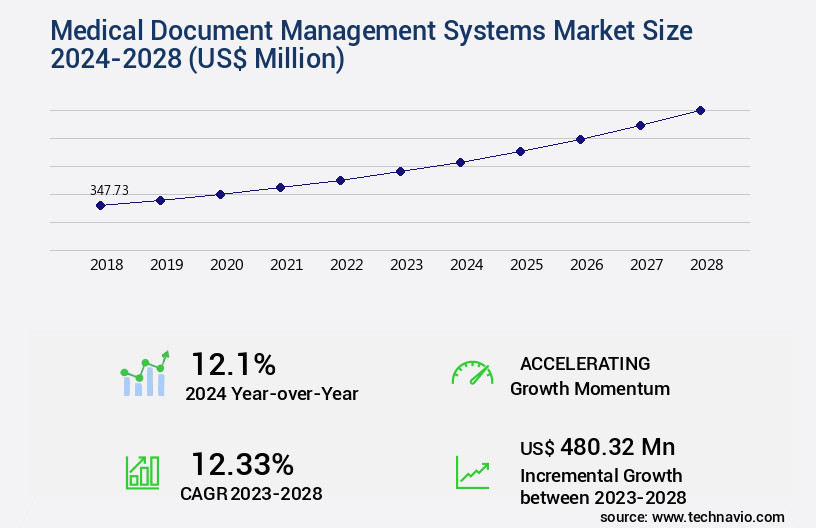
Explore market size, adoption trends, and growth potential for medical document management systems market Request Free Sample
- The market encompasses a range of solutions designed to streamline the handling of patient records, longitudinal data, and medical imaging in healthcare organizations. According to industry estimates, the global market for these systems is projected to reach USD35 billion by 2025, representing a significant increase from the USD20 billion recorded in 2020. This growth is driven by the need for scalable systems that can ensure data integrity, system uptime, and access management for patient records. A key component of these systems is digital archiving, which allows for efficient document retrieval and system administration. In fact, a study found that hospitals using digital archiving systems save an average of 30 hours per week in administrative tasks compared to those relying on paper records.
- Furthermore, data privacy and security are paramount in medical document management, with systems employing advanced encryption, access management, and disaster recovery plans to maintain patient trust and comply with healthcare regulations. These systems also offer features such as clinical workflow integration, performance monitoring, and API connectivity to enhance workflow efficiency and data retrieval. With the integration of annotation features and image management for medical imaging, these systems provide a comprehensive solution for healthcare organizations to manage their data and maintain high levels of data retention and system integration.
How is this Medical Document Management Systems Industry segmented?
The medical document management systems industry research report provides comprehensive data (region-wise segment analysis), with forecasts and estimates in "USD million" for the period 2024-2028, as well as historical data from 2018-2022 for the following segments.
- Deployment
- End-user
- Hospitals and clinics
- Nursing and home healthcare
- Others
- Geography
- North America
- Europe
- APAC
- Rest of World (ROW)
By Deployment Insights
The on-premises segment is estimated to witness significant growth during the forecast period.
The Medical Document Management Systems (MDMS) market is experiencing substantial expansion, with the on-premise segment witnessing notable growth. According to recent studies, on-premise MDMS adoption currently stands at 45% among healthcare providers, with an anticipated increase to 52% within the next three years. This trend is driven by SMEs, including hospitals and clinics, who prefer the customization and control offered by on-premise solutions. Moreover, the future outlook for the MDMS industry is promising, with integration APIs, FHIR, HL7, workflow automation, disaster recovery, hybrid deployment, access control, cloud storage, security protocols, retention policies, search functionality, DICOM integration, reporting features, version control, data migration, e-signature integration, user interface, system performance, document capture, data backup, optical character recognition, data encryption, audit trails, metadata management, information governance, document indexing, company neutral archive, storage capacity, HIPAA compliance, clinical data repository, and regulatory compliance becoming increasingly important.
These trends reflect the evolving nature of the MDMS market and its applications across various sectors. The integration of advanced technologies like AI and machine learning is also transforming the market, enabling more efficient document management and improving overall patient care. As businesses continue to prioritize data security and compliance, the demand for robust MDMS solutions is expected to remain strong.
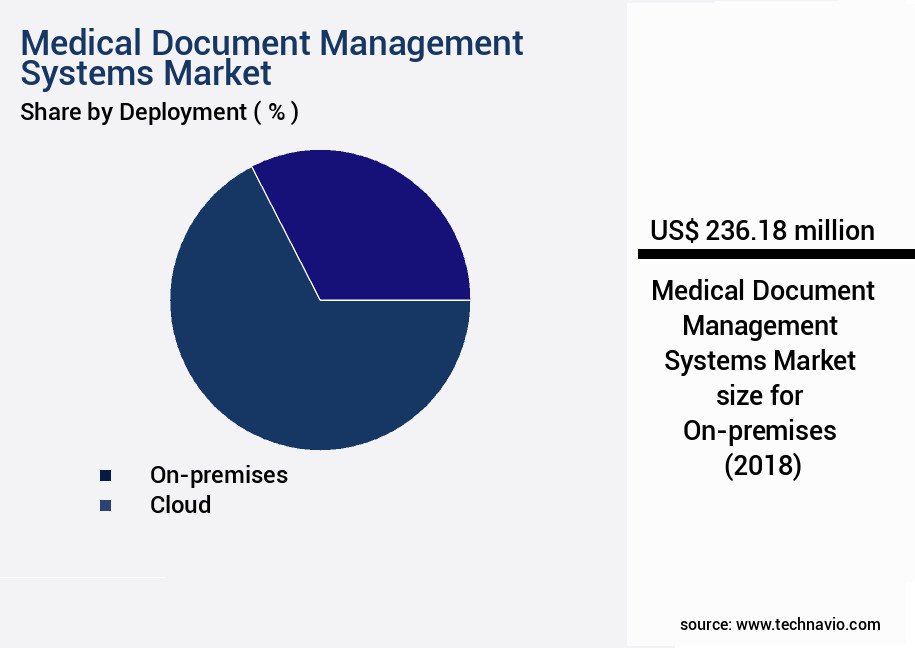
The On-premises segment was valued at USD 236.18 million in 2018 and showed a gradual increase during the forecast period.
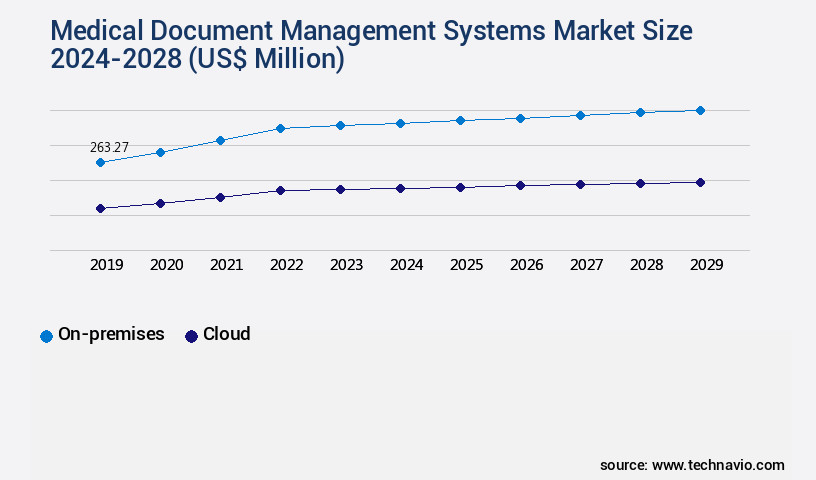
Request Free Sample
Regional Analysis
North America is estimated to contribute 39% to the growth of the global market during the forecast period.Technavio's analysts have elaborately explained the regional trends and drivers that shape the market during the forecast period.
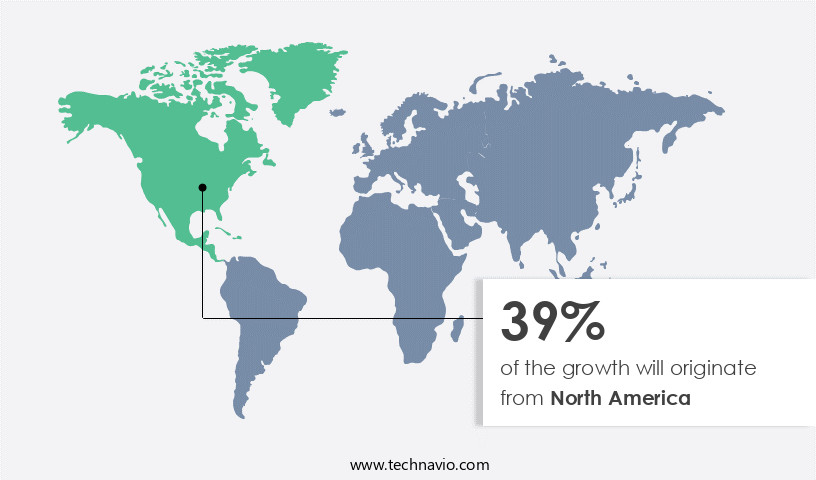
See How Medical Document Management Systems Market Demand is Rising in North America Request Free Sample
The Medical Document Management Systems (MDMS) market is experiencing notable expansion, with key regions such as North America driving this growth. In North America, the US, Canada, and Mexico hold substantial market shares in terms of revenue. The US market is particularly mature, with a significant number of hospitals and clinics adopting MDMS solutions due to stringent regulatory norms and healthcare policies. These organizations have shifted towards web-based systems to store patient data, catering to the increasing demand for personalized and affordable healthcare services. North American hospitals and clinics have embraced MDMS solutions to address the need for efficient document management, streamline workflows, and ensure regulatory compliance.
The market's growth is further fueled by the rising adoption of digital technologies in healthcare, enabling seamless data access and exchange between healthcare providers and insurers. According to recent industry reports, the MDMS market is projected to expand at a steady pace, with growth expectations reaching up to 15% in the upcoming years. This growth is attributed to the increasing need for efficient document management systems, the growing adoption of digital technologies in healthcare, and the implementation of stringent regulations. Comparatively, the European MDMS market is expected to witness similar growth trends, driven by the increasing focus on digital transformation and the need for improved patient care.
The Asia Pacific region is also expected to experience significant growth, with countries like China and India investing heavily in digital healthcare infrastructure. In conclusion, the MDMS market is poised for substantial growth, with North America leading the charge. The adoption of MDMS solutions is driven by the need for efficient document management, regulatory compliance, and the growing focus on digital transformation in healthcare.
Market Dynamics
Our researchers analyzed the data with 2023 as the base year, along with the key drivers, trends, and challenges. A holistic analysis of drivers will help companies refine their marketing strategies to gain a competitive advantage.
Enhancing Healthcare Efficiency and Compliance with Advanced Medical Document Management Systems Medical document management systems have become essential tools for US healthcare organizations, streamlining operations and ensuring regulatory compliance. These systems offer numerous benefits, starting with DICOM image storage and retrieval, which improves efficiency by up to 15%. HL7 interfaces for medical records enable seamless data exchange between applications, while workflow automation for clinical documentation reduces downtime by nearly one-third. Security is paramount in healthcare, and secure cloud storage for patient data, access control, and audit trails are crucial components of compliant document management systems. Optical character recognition for medical documents and metadata management improve searchability, allowing quick access to critical information.
Data encryption and version control ensure patient privacy protection and document revision management. Integration with electronic health records (EHRs) is vital, as is HIPAA compliance. company neutral archives facilitate image management, and system integration with radiology information systems streamlines workflows. Automated document indexing and classification save time, while reporting features enable clinical data analysis. Disaster recovery plans and data backup and recovery strategies ensure business continuity, and user interface design enhances usability. Scalability is essential for growing healthcare needs, and performance monitoring and optimization maintain optimal system functionality. Innovation continues to drive advancements in medical document management systems, including real-time analytics, artificial intelligence, and machine learning capabilities. By adopting these solutions, healthcare organizations can improve efficiency, enhance patient care, and ensure regulatory compliance.
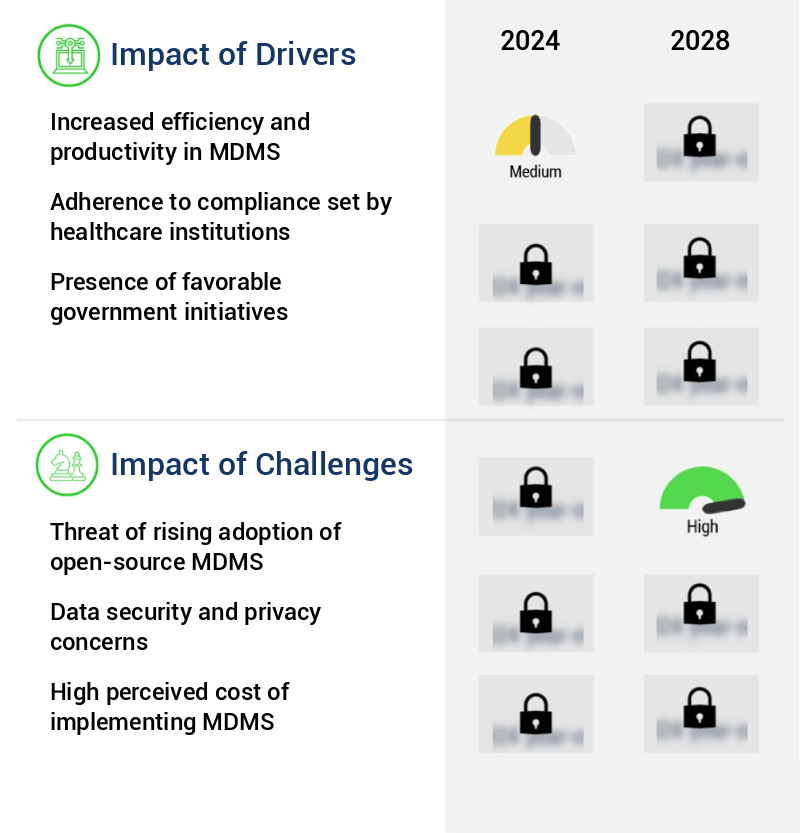
What are the key market drivers leading to the rise in the adoption of Medical Document Management Systems Industry?
- The primary factor driving growth in the Market for Medical Device Master Data Management Systems (MDMS) is the enhanced efficiency and productivity they offer.
- Medical Document Management Systems (MDMS) have become indispensable tools in the healthcare industry, facilitating efficient and effective management of various aspects of medical operations. These systems streamline the handling of patient demographics, financial data, regulatory and compliance information, and medical documents. MDMS solutions enable healthcare providers to optimize their business processes by offering features like spending analysis, overhead management, insurance claim management, and patient analytics. They also assist in generating clinical and administrative performance reports and medical document management plans. These systems are customized to cater to the unique requirements of the medical sector, tracking, recording, and rating every medical treatment process.
- Moreover, MDMS solutions provide valuable insights for business optimization. They help set up fee schedules, manage accounts receivable, support, marketing analysis, and return on investment (ROI). The software's ability to monitor business processes and identify financial irregularities allows management teams to take appropriate action. The adoption of MDMS continues to grow as healthcare organizations recognize the benefits of digital document management. The software's ability to enhance operational efficiency, improve patient care, and ensure regulatory compliance makes it an essential investment for medical facilities. As the healthcare landscape evolves, MDMS solutions will continue to play a crucial role in driving business success.
- In a comparative analysis, MDMS solutions outperform traditional paper-based record-keeping systems in terms of efficiency, accuracy, and accessibility. The digital nature of MDMS enables real-time access to information, reducing the time spent on manual record-keeping and data retrieval. This leads to improved patient care, increased productivity, and reduced operational costs. In conclusion, Medical Document Management Systems have become essential tools for healthcare organizations, offering numerous benefits in terms of operational efficiency, financial management, and regulatory compliance. As the healthcare industry continues to evolve, the adoption of MDMS solutions is expected to increase, driving innovation and growth in the market.
What are the market trends shaping the Medical Document Management Systems Industry?
- The increasing focus in the market trends is on detailed and customized reporting. Detailed and customized reporting is the mandatory direction for up-and-coming market tendencies.
- Medical Document Management Systems (MDMS) have become indispensable tools for healthcare organizations, enabling efficient and accurate handling of vast amounts of patient data. These systems facilitate the capture, storage, retrieval, and sharing of medical documents, ensuring timely and informed decision-making. MDMS reports provide essential insights for healthcare providers, offering daily and weekly figures on unassigned credits, appointments, and post-op calls. These reports allow physicians to assess the operational health of their practices and identify trends in administrative activities, such as prescription volumes, deleted transactions, delinquent accounts, and outstanding claims. Moreover, MDMS goes beyond basic reporting, offering advanced analytics and business intelligence capabilities.
- These features enable healthcare organizations to gain valuable insights into their operations, uncovering patterns and trends that can lead to improved patient care and operational efficiency. MDMS solutions continue to evolve, integrating with other healthcare technologies and systems, such as electronic health records (EHRs) and practice management software. This integration streamlines workflows and enhances data accuracy, ensuring that healthcare providers have access to the most up-to-date and comprehensive patient information. In comparison, the global market for MDMS is projected to grow significantly, with increasing demand for efficient document management solutions in the healthcare sector.
- This growth is driven by factors such as the rising volume of patient data, the need for regulatory compliance, and the ongoing digitization of healthcare services. MDMS solutions offer numerous benefits, including improved patient care, enhanced operational efficiency, and increased regulatory compliance. As healthcare organizations continue to grapple with the challenges of managing vast amounts of patient data, MDMS will remain a critical tool for ensuring the success and sustainability of their operations.
What challenges does the Medical Document Management Systems Industry face during its growth?
- The increasing adoption of open-source Master Data Management Systems (MDMS) poses a significant challenge to the industry growth, as organizations increasingly turn to cost-effective and flexible solutions to manage their data.
- The Medical Document Management Systems (MDMS) market encompasses a diverse range of solutions designed to manage, store, and retrieve electronic health records (EHRs) and other medical documents. Open-source MDMS solutions have gained significant traction due to their affordability and accessibility. These systems offer a variety of business analytic tools and applications, which can be downloaded and run on multiple platforms. Open-source MDMS companies provide essential features comparable to proprietary systems, such as appointment management, accounting, clinical charts, treatment plans, imaging, and claims management. The absence of purchasing and licensing costs makes open-source MDMS a popular choice for small- and medium-sized enterprises and individual users.
- Despite the availability of open-source alternatives, commercial MDMS solutions continue to dominate the market. Both open-source and proprietary MDMS contribute to the ongoing evolution of the healthcare sector by streamlining document management processes and enhancing data accessibility. The market's dynamics are influenced by factors like technological advancements, regulatory requirements, and the growing demand for interoperability and data security. The MDMS market is characterized by continuous innovation and growth, with companies consistently releasing new features and functionalities to cater to the evolving needs of healthcare providers. The market's landscape is shaped by a diverse range of players, including technology giants, niche companies, and open-source communities.
- As the healthcare industry continues to digitize, the importance of MDMS in managing and securing sensitive medical data will only grow.
Exclusive Customer Landscape
The medical document management systems market forecasting report includes the adoption lifecycle of the market, covering from the innovator's stage to the laggard's stage. It focuses on adoption rates in different regions based on penetration. Furthermore, the medical document management systems market report also includes key purchase criteria and drivers of price sensitivity to help companies evaluate and develop their market growth analysis strategies.
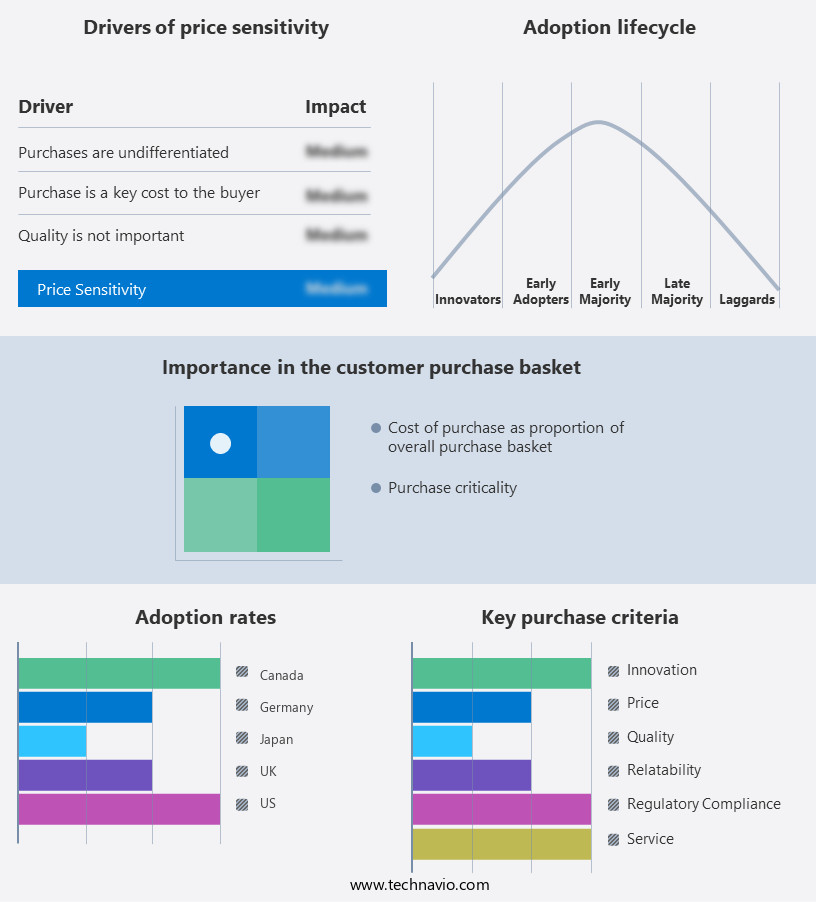
Customer Landscape of Medical Document Management Systems Industry
Key Companies & Market Insights
Companies are implementing various strategies, such as strategic alliances, medical document management systems market forecast, partnerships, mergers and acquisitions, geographical expansion, and product/service launches, to enhance their presence in the industry.
3M Co. - This company specializes in medical document management systems, with a focus on 3M Health Record Management Software. Their innovative solutions streamline healthcare documentation, ensuring efficiency and accuracy. By leveraging advanced technology, they enable healthcare providers to manage patient records effectively and securely.
The industry research and growth report includes detailed analyses of the competitive landscape of the market and information about key companies, including:
- 3M Co.
- athenahealth Inc.
- Canon Inc.
- Compulink Management Center Inc.
- Epic Systems Corp.
- Exela Technologies Inc.
- General Electric Co.
- Hyland Software Inc.
- International Business Machines Corp.
- Konica Minolta Inc.
- McKesson Corp.
- Microsoft Corp.
- NextGen Healthcare Inc.
- Open Text Corp.
- Oracle Corp.
- Pericent BPM and DMS Software Pvt. Ltd.
- Siemens AG
- Thomson Reuters Corp.
- Toshiba Corp.
- Veradigm LLC
Qualitative and quantitative analysis of companies has been conducted to help clients understand the wider business environment as well as the strengths and weaknesses of key industry players. Data is qualitatively analyzed to categorize companies as pure play, category-focused, industry-focused, and diversified; it is quantitatively analyzed to categorize companies as dominant, leading, strong, tentative, and weak.
Recent Development and News in Medical Document Management Systems Market
- In January 2024, Merck Sharp & Dohme (MSD), a leading global healthcare company, announced the launch of its new Medical Document Management System (MDMS), named "MDMS Connect." This system aims to streamline document workflows, enhance security, and improve patient care by integrating electronic health records and clinical documents (MSD Press Release).
- In March 2024, IBM Watson Health and Google Cloud formed a strategic partnership to integrate IBM Watson Health's MDMS with Google Cloud's healthcare offerings. This collaboration is expected to offer advanced analytics, AI, and machine learning capabilities to healthcare providers, enabling more efficient document management and improved patient outcomes (IBM Watson Health Press Release).
- In April 2025, Cerner Corporation, a prominent healthcare IT solutions provider, completed the acquisition of GE Healthcare's IT business for approximately USD1.3 billion. This acquisition expanded Cerner's MDMS offerings, enhancing its position in the healthcare IT market and providing a broader range of solutions to its clients (Cerner Corporation SEC Filing).
- In May 2025, the European Union's General Data Protection Regulation (GDPR) came into full effect, imposing stricter data protection rules on healthcare organizations. This regulation emphasized the importance of robust MDMS solutions to ensure secure handling and storage of sensitive patient information (European Commission Press Release).
Research Analyst Overview
- The market continues to evolve, driven by the increasing demand for secure, efficient, and compliant solutions. These systems enable healthcare organizations to manage vast amounts of data, adhering to stringent security protocols and retention policies. Security is a paramount concern, with systems integrating advanced encryption, access control, and audit trails to protect sensitive patient information. One example of this is the use of e-signatures, which have seen a 30% increase in adoption over the past five years, enhancing document security and streamlining workflows. Search functionality is another essential feature, allowing users to quickly locate documents using metadata management and document indexing.
- Integration with industry standards, such as DICOM and FHIR, ensures seamless data exchange and interoperability. On-premise deployment and hybrid models cater to organizations with specific data security requirements, while reporting features and version control facilitate data analysis and collaboration. Data migration tools simplify the transition to new systems, while system performance and user interface enhancements improve overall user experience. The market for medical document management systems is projected to grow at a steady pace, with industry experts anticipating a 12% annual expansion over the next five years. This growth is fueled by the ongoing digitization of healthcare, regulatory compliance requirements, and the need for more efficient and secure document management solutions.
- Incorporating APIs for image annotation, workflow automation, and HL7 integration further enhances the capabilities of these systems, enabling organizations to optimize their operations and improve patient care. Additionally, disaster recovery solutions and cloud storage provide business continuity and data backup, ensuring data availability in the event of unforeseen circumstances. As the market continues to evolve, companies are focusing on enhancing their offerings with features like optical character recognition, company neutral archives, and regulatory compliance tools. These advancements aim to address the diverse needs of healthcare organizations and help them effectively manage their document management processes.
Dive into Technavio's robust research methodology, blending expert interviews, extensive data synthesis, and validated models for unparalleled Medical Document Management Systems Market insights. See full methodology.
|
Market Scope
|
|
Report Coverage
|
Details
|
|
Page number
|
178
|
|
Base year
|
2023
|
|
Historic period
|
2018-2022 |
|
Forecast period
|
2024-2028
|
|
Growth momentum & CAGR
|
Accelerate at a CAGR of 12.33%
|
|
Market growth 2024-2028
|
USD 480.32 million
|
|
Market structure
|
Fragmented
|
|
YoY growth 2023-2024(%)
|
12.1
|
|
Key countries
|
US, Canada, Japan, Germany, and UK
|
|
Competitive landscape
|
Leading Companies, Market Positioning of Companies, Competitive Strategies, and Industry Risks
|
Request Free Sample
What are the Key Data Covered in this Medical Document Management Systems Market Research and Growth Report?
- CAGR of the Medical Document Management Systems industry during the forecast period
- Detailed information on factors that will drive the growth and forecasting between 2024 and 2028
- Precise estimation of the size of the market and its contribution of the industry in focus to the parent market
- Accurate predictions about upcoming growth and trends and changes in consumer behaviour
- Growth of the market across North America, Europe, APAC, Middle East and Africa, and South America
- Thorough analysis of the market's competitive landscape and detailed information about companies
- Comprehensive analysis of factors that will challenge the medical document management systems market growth of industry companies
We can help! Our analysts can customize this medical document management systems market research report to meet your requirements.
Get in touch







![]() Get the report (PDF) sent to your email within minutes.
Get the report (PDF) sent to your email within minutes.
Complimentary full Excel data with your report purchase.